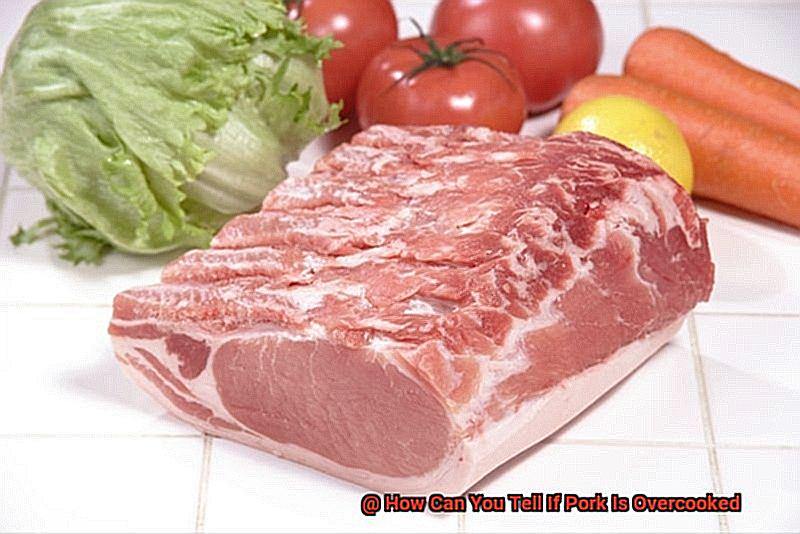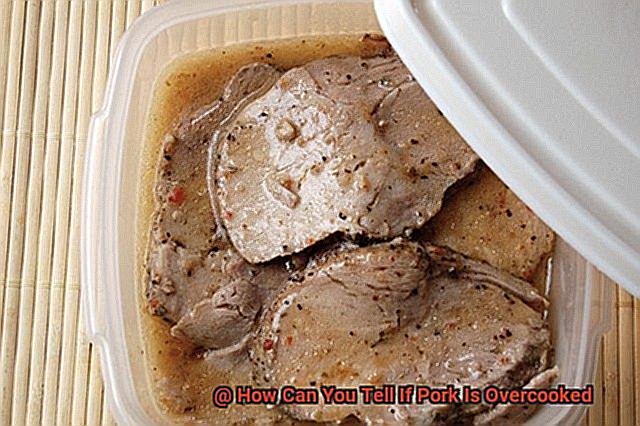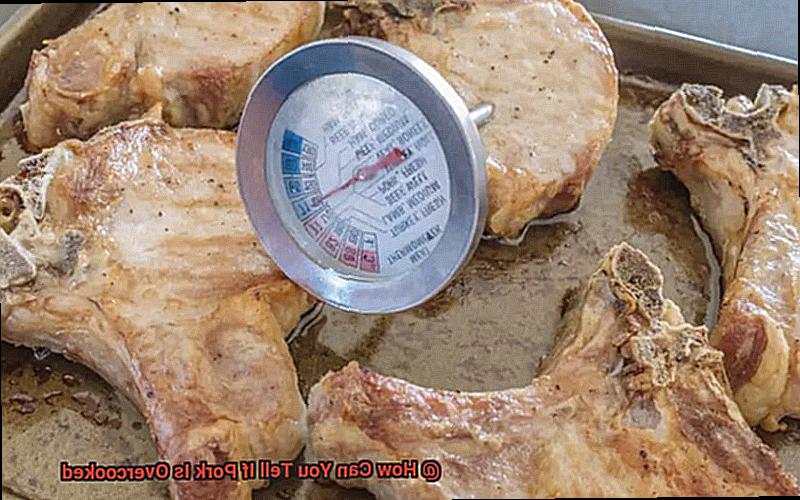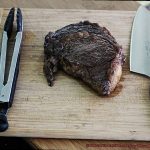Who doesn’t love a succulent piece of pork that melts in your mouth with every bite? But let’s face it, achieving that perfect tenderness can be a bit tricky. As a home cook, have you ever found yourself wondering if you’ve overcooked your pork? Don’t worry, we’ve got your back.
Overcooked pork can turn dinner into a major disappointment. From an unappetizing dry and tough texture to an unpleasant taste, getting it just right can be quite the challenge. But fear not fellow foodies, the signs of overcooked pork are fairly easy to spot and there are preventative measures you can take to avoid it altogether.
In this article, we’ll dive deep into the different visual and physical clues that indicate whether or not your pork is overcooked. We’ll also share some tips and tricks to help you avoid tough and flavorless meat so that you can ensure your pork stays juicy, tasty, and perfectly cooked every time.
Whether you’re a seasoned chef or just starting out on your culinary journey, this article will provide all the information you need to know about how to tell if your pork is overcooked. So sit tight and get ready to become a pro at cooking deliciously tender pork.
Contents
Check the Internal Temperature of the Meat
Pork is a delectable meat that can be cooked in various ways. However, overcooking it can ruin your dish, leaving it dry, tough and unappetizing. So how can you ensure that your pork is cooked perfectly? The answer lies in checking the internal temperature of the meat.

To check the internal temperature of pork, use a meat thermometer. Insert it into the thickest part of the meat without touching any bone or fat. The United States Department of Agriculture (USDA) recommends cooking pork to an internal temperature of 145°F (63°C) with a three-minute rest time before carving or consuming.
Ensuring that pork is cooked thoroughly and safely is vital, but color alone isn’t always an accurate indicator of doneness. Some cuts may still appear pink when fully cooked, while others may turn brown before reaching the recommended internal temperature.
A good quality meat thermometer is essential in preventing overcooking and ensuring food safety. However, if you don’t have one, there’s another way to check if the pork is overcooked using a fork or tongs. Press it gently and if the juices run clear, then the meat is cooked correctly. However, this method isn’t always reliable as some cuts may release clear juices even when undercooked.
Overcooking pork can be identified by its texture, moisture, flavor, and color. Overcooked pork can be dry and tough to chew with a rubbery texture or feel stringy when pulled apart. Additionally, overcooked pork may lack moisture and flavor and lose its natural juices, becoming bland. Lastly, overcooked pork may have a grayish-brown color instead of a pinkish hue.
To avoid ruining your meal with overcooked pork, invest in a good quality meat thermometer and follow USDA recommendations for cooking temperatures. Remember to allow the pork to rest for three minutes before carving or consuming. This will ensure that your pork is juicy, tender, and flavorful every time.
Consider the Texture of the Pork
The texture of pork is a crucial factor in determining whether it’s overcooked or not. Overcooked pork has a dry and tough texture that can be unappetizing and unpleasant to eat.

There are several ways to check the texture of your cooked pork. One method is to use a fork or knife to cut into the meat. If the meat feels tough and dry, it is likely overcooked. Alternatively, you can press down on the meat with your finger. If there is no moisture or give in the meat, it is also likely overcooked.
It’s worth noting that different cuts of pork may have slightly different textures when cooked properly. For instance, lean cuts like tenderloin will have a more delicate texture than fattier cuts like shoulder or belly. Understanding what texture you’re looking for based on the cut of pork you’re cooking is crucial.
According to the USDA, pork should be cooked until it reaches an internal temperature of 145°F (63°C). This temperature ensures that harmful bacteria are destroyed without overcooking the meat. However, even if you’ve cooked your pork to the correct temperature, it can still be overcooked if left on the heat for too long.
So what’s the solution? Keep a close eye on your pork as it cooks and take it off the heat at the right moment. Remember that resting time is also crucial; allowing your pork to rest for three minutes after cooking will help retain its juices and give you a moist and tender final product.
Analyze the Moisture and Flavor of the Pork
This is crucial in ensuring that your pork is cooked to perfection and bursting with flavor.
Let’s start with moisture. While cutting into the pork can give you an idea of its moisture level, it’s not always reliable. That’s why investing in a meat thermometer is a must. When the pork reaches an internal temperature of 145°F (63°C), it will be perfectly juicy and tender. However, exceeding this temperature can lead to a dry and tough texture. So keep a close eye on that thermometer.
Moving on to flavor, overcooked pork can be bland and lack depth. To avoid this, it’s crucial to cook the pork until it’s just done and not beyond that point. But don’t stop there. Experiment with different herbs, spices, and marinades to enhance the flavor profile of your dish.
Inspect the Color of the Pork
One key element to inspecting the color of pork is to ensure that it’s not overcooked or undercooked. In this guide, we’ll explore how to get the perfect color for your pork and avoid any potential health hazards.
Firstly, let’s talk about why inspecting the color of pork is crucial. Pork should never be consumed if it’s still pink in the middle as this can lead to foodborne illnesses. On the other hand, overcooking pork can result in tough and chewy meat. So, how do we find that sweet spot?
To begin with, make a small cut into the thickest part of the meat and check the interior. The meat should appear white or slightly pink but not raw or excessively pink. If the pork is still pink or has a reddish hue, it may need to be cooked for a few more minutes. It’s essential to note that different cuts of pork may have slightly different colors when fully cooked. For example, pork loin may appear slightly pinker than pork shoulder or ribs even when fully cooked.
However, don’t rely solely on the color of your meat to determine if it’s cooked thoroughly. It’s also fundamental to use a meat thermometer and check the internal temperature of the pork. The USDA recommends cooking pork to an internal temperature of 145°F (63°C) followed by a three-minute rest time before cutting into it.
Another essential tip is to let your meat rest for a few minutes before cutting into it. This will allow the juices to redistribute throughout the meat and keep it juicy and flavorful.
Use a Meat Thermometer for Precision
Cooking pork can be a tricky task, but with the help of a meat thermometer, you can achieve the perfect doneness every time. As a kitchen tool that measures the internal temperature of meat, a meat thermometer allows you to check if your pork has reached a safe and optimal cooking temperature.
To use a meat thermometer for precision, simply insert the probe into the thickest part of the pork, ensuring it doesn’t touch any bone. Take the temperature reading before removing the pork from the heat source. A general rule of thumb is to cook pork to an internal temperature of 145°F (63°C) for medium-rare, 160°F (71°C) for medium, and 170°F (77°C) for well-done.
Using a meat thermometer provides precision and accuracy in determining if your pork is properly cooked while also ensuring that it’s safe to eat. Here are some reasons why using a meat thermometer is important:
- Ensures Safe Consumption: It’s essential to cook pork to a specific temperature to kill harmful bacteria such as Salmonella and E. coli. The only way to know if your pork has reached that temperature is by using a meat thermometer.
- Prevents Overcooking: Overcooked pork can be tough and dry, which can result in an unappetizing and difficult-to-eat texture. By using a meat thermometer, you can avoid overcooking your pork and achieve a juicy and flavorful result every time.
- Saves Time and Money: Overcooked pork leads to waste, which can be both time-consuming and costly. Using a meat thermometer can prevent this from happening, saving you both time and money.
Different Cuts of Pork Require Different Cooking Times
Cooking pork is an art form that requires precision and knowledge. Different cuts of pork require different cooking times, and mastering this aspect is crucial to achieving perfectly cooked meat. As an expert on all things pork, I’m here to guide you through the maze of pork cuts and cooking times.
Firstly, let’s talk about the delicate pork tenderloin. This lean cut of meat is a crowd favorite, but it can easily become tough if overcooked. To ensure it stays juicy and tender, cook your pork tenderloin to an internal temperature of 145°F and let it rest for a few minutes before slicing.
Moving on to tougher cuts such as pork shoulder or pork butt, these cuts require a longer cooking time to break down the connective tissues and become tender. To achieve mouth-watering pulled pork, cook these cuts low and slow at around 200-225°F for several hours until they reach an internal temperature of 195-205°F.
Pork chops come in various thicknesses, making them a bit more challenging to cook. Thicker chops require longer cooking times than thinner ones, making it essential to use a meat thermometer to achieve perfection. For a delectable pork chop, aim for an internal temperature of 145°F.
It is vital to know the recommended cooking times for different cuts of pork to avoid overcooking or undercooking your meat. Using a meat thermometer is the most accurate way to check the internal temperature and ensure that your pork is cooked perfectly every time.
Avoid Overcooking to Maintain Juiciness and Flavor
Therefore, I have conducted extensive research on the importance of avoiding overcooking and how to do so.
Firstly, let’s discuss the tell-tale signs of overcooked pork. If your meat thermometer reads above 145°F (63°C), then your pork is most likely overcooked and in danger of becoming dry and tough. Additionally, overcooked pork will appear dull and grayish instead of the pinkish color typical of cooked pork. And finally, when you cut into overcooked pork, you’ll notice that it lacks juiciness and has a dry, chewy texture.
To avoid these pitfalls, we must monitor the temperature while cooking and remove the pork from heat once it reaches 145°F (63°C). Letting your pork rest for several minutes before slicing it will also help ensure that it stays juicy and flavorful. Remember, different cuts of pork require different cooking times – tenderloin needs less time than tougher cuts like shoulder or butt.
Apart from the practical tips for avoiding overcooked pork, let’s explore why it’s essential to do so. Firstly, overcooked meat loses its delicious flavor and juicy texture that makes pork so desirable. Furthermore, overcooked pork can be tough and difficult to eat, making it an unenjoyable experience altogether.
So how can we ensure we cook our pork to perfection? Here are some additional tips:
- Brine your pork before cooking to help retain moisture
- Avoid piercing the meat with a fork as it can release juices
- Use a meat thermometer to check the internal temperature
- Experiment with different cooking methods such as grilling, roasting, or slow cooking
oomojTheW5Y” >
Conclusion
In conclusion, cooking pork to perfection is an art form that requires knowledge and precision. Overcooked pork can be a disaster, leaving your dish dry, tough, and unappetizing. Luckily, there are several ways to tell if your pork is overdone.
The most reliable method is to use a meat thermometer to check the internal temperature of the meat. The USDA recommends cooking pork to 145°F (63°C) with a three-minute rest time before serving. You can also analyze the texture, moisture, flavor, and color of the pork to determine if it’s overcooked.
It’s important to note that different cuts of pork require different cooking times and techniques. To avoid overcooking your pork, use a meat thermometer for accuracy and remove it from heat once it reaches the recommended temperature. Allowing your pork to rest for several minutes before slicing will help retain its juices and ensure that it remains juicy and flavorful.
Overcooked pork doesn’t have to ruin your meal – by following these tips and tricks, you can cook tender and succulent pork every time.






